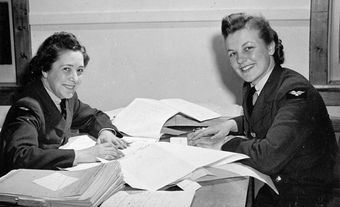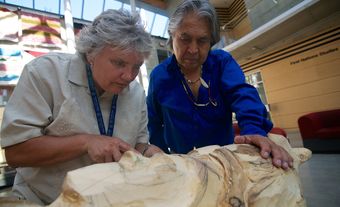Margaret Pictou LaBillois, CM, ONB, air force photographer, businesswoman, Mi’kmaw Chief, Elder, language and culture advocate (born 10 July 1923 in Eel River Bar First Nation [now Ugpi’Ganjig] NB; died 19 April 2013 in Dalhousie, NB). Elder Margaret LaBillois was the first elected female Chief in New Brunswick. After wartime service, LaBillois returned to her First Nation, where she was instrumental in reviving an interest in the Mi’kmaw language and traditional crafts, as well as starting a family co-operative business.

Early Life
Elder Margaret LaBillois was one of eight children (five girls and three boys) of James and Mary Paul Pictou. After her father died, her grandfather took a prominent role in her life. She spent much of her childhood fishing and picking berries with him. LaBillois attended Indian day school. In 1939, she became the first person from her community to graduate from high school, including with honours.
After graduation, LaBillois began training as a nurse at the Hotel Dieu Hospital in Campbellton, about 25 km away by train. However, she thought the nursing fees were too much for her mother, who was raising a family by herself. For income, her mother cleaned houses of other people in nearby Dalhousie but had to walk five kilometres each way to do so.
In addition, the train back and forth to Campbellton cost money — as did the white stockings LaBillois had to provide for her nurse’s uniform, which had to be replaced frequently. Although she loved training to be a nurse, the costs weighed heavily on her. Then, a chance encounter with a Royal Canadian Air Force (RCAF) recruiter on a train back home led to her enlistment. LaBillois was told she could send part of her pay to her mother, which contributed to her decision to enlist.
Wartime Service
Elder Margaret LaBillois joined the RCAF Women’s Division. After basic training, she went to RCAF Station Rockcliffe near Ottawa, where she learned to be a photo-reconnaissance technician. Part of her job as an aircraftswoman first class entailed hanging out of airplanes to take photographs of roads and bridges. LaBillois later recalled being told by a superior, “If you drop the camera you might as well jump after it. It will take you forever to pay for it.”
LaBillois also worked on aerial photographs that were used to map the route for the Alaska Highway. Because of fears of a Japanese invasion of the west coast of North America, the highway was an important wartime construction project to link the United States with Alaska through Canada.
Several men from Eel River Bar also enlisted during the war, including some of LaBillois’s brothers and her future husband. In 1944, her adopted brother, Matthew, died in England while serving with the Canadian army. Another brother also died while serving overseas. When the Second World War ended, LaBillois returned to her First Nation after two and a half years of service.
She and Michael LaBillois, who worked at the paper mill in Dalhousie, began to date and then got married. Together they had six boys and six girls and adopted two more boys. The two adopted children were part of their extended family. LaBillois and her husband could not bear the thought of them being raised by non-family members.
Chief
In 1970, Elder Margaret LaBillois became the first woman to be elected a First Nation Chief in New Brunswick and served two terms. During that time, she fostered partnerships between Indigenous and non-Indigenous individuals and peoples, as well as government agencies. According to the citation for the award of the Member of the Order of Canada, her actions “produced a climate of mutual understanding and respect. As a result of her enlightened leadership the people of Eel River have reclaimed lands lost through development and rediscovered their traditions and language.”
Mi’kmaw Advocate
When her second term as Chief ended, Elder Margaret LaBillois made it her mission to restore the Mi’kmaw language and culture to her people. She recalled her time at day school when she was only allowed to speak English. As a result, she could not remember certain Mi’kmaw words when she came home. However, her mother and a sister forced her to speak their mother tongue, which LaBillois continued to do with family.
LaBillois became convinced that language was key to her people’s identity. To assist her in promoting this, she took a degree in Indigenous languages at Lakehead University in Thunder Bay and graduated with honours in 1982. Her eldest daughter, Colleen, left school to stay at home to look after her siblings while her mother went to university. Back at Eel River Bar First Nation, LaBillois visited local schools to teach students the Mi’kmaw language, culture and traditions. She was also a strong advocate of teaching respect and mutual understanding of Mi’kmaw culture to all levels of government.
Businesswoman
Elder Margaret LaBillois also started a family co-operative business called Apitjipeg, which means “rebirth.” Its wide-ranging efforts include making and selling jewellery, mittens, moccasins and snowshoes, operating a lobster shop and restaurant, and even organizing social and cultural events. LaBillois’s children and grandchildren are involved in its operation.
“Change the Bill”
In 2023, the Native Women’s Association of Canada launched “Change the Bill,” a project to promote the contributions and accomplishments of Indigenous women through art. The association commissioned nine Indigenous artists to reimagine the $20 bill with Indigenous women who were their heroes. Mi’kmaw artist Tracey Metallic chose Elder Margaret LaBillois for her entry, which pictured LaBillois in her RCAF uniform. An exhibit of the proposed designs ran in a Toronto art gallery.
Honours and Awards
Before Elder Margaret LaBillois died in 2013 at the Dalhousie Nursing Home, aged 89, she had received high accolades. She was appointed as a Member of the Order of Canada in 1995 to recognize her leadership qualities and significant demonstration of traditional Mi’kmaw skills. Ten years later, in 2005, she was awarded the Order of New Brunswick in acknowledgement of her leadership and protection of the Mi’kmaw language. LaBillois was also made an Elder of the Union of New Brunswick Indians.

 Share on Facebook
Share on Facebook Share on X
Share on X Share by Email
Share by Email Share on Google Classroom
Share on Google Classroom



